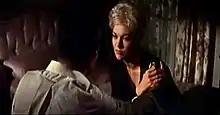Strangers When We Meet (film)
Strangers When We Meet is a 1960 drama film about two married neighbors who have an affair. The movie was adapted by Evan Hunter from his novel of the same name and directed by Richard Quine. The film stars Kirk Douglas, Kim Novak, Ernie Kovacs, Barbara Rush, and Walter Matthau.
| Strangers When We Meet | |
|---|---|
 | |
| Directed by | Richard Quine |
| Produced by | Richard Quine Bryna Productions Richard Quine Productions |
| Written by | Evan Hunter |
| Starring | Kirk Douglas Kim Novak Ernie Kovacs Barbara Rush Walter Matthau |
| Music by | George Duning |
| Cinematography | Charles Lang |
| Edited by | Charles Nelson |
Production company | |
| Distributed by | Columbia Pictures |
Release date |
|
Running time | 117 minutes |
| Country | United States |
| Language | English |
| Box office | $3,400,000 (US/ Canada)[1] |

The picture was filmed in Los Angeles, with scenes shot in Beverly Hills, Brentwood, Bel Air, Santa Monica, and Malibu.
Plot
Larry Coe is a Los Angeles architect who is married with two kids. He has a very bright wife, Eve. She is ambitious for him, but he wants to do work more imaginative than the commercial buildings he's been designing. He meets with Roger Altar, an author, to discuss building a house that will be an "experiment" and something Coe wants to do more of, something original.
Maggie Gault is one of his neighbors whose son is friends with his. She tells Larry she has seen some of his previous houses and thinks that the more unconventional houses are the best. This encouragement is what he needs from his wife but hasn't been able to get.
Both Larry and Maggie grow dissatisfied in their marriages. Larry's wife is too hard-headed and practical and Maggie's husband isn't interested in having sex with her. So they have an affair that involves meeting in secret. They both know what they're doing is wrong, and they are devoted to their children.
Felix Anders is a neighbor who snoops around and finds out about their affair. His leering and insinuations make Larry realize the risks he's taking. He tells Maggie that they shouldn't see each other for a while. Felix, in the meantime, makes a play for Larry's wife. In a way, Felix is a personification of the tawdriness of Larry and Maggie's affair.
After her near-rape by Felix, Eve wises up and realizes that Larry has been unfaithful. She confronts him. They agree to stay together and move to Hawaii, where Larry has been offered a job to design a city.
Altar's house is finished but still empty. After Larry phones her, Maggie makes one last appointment to meet him at the newly completed home. Therein Maggie drives up to take a look at it. Larry shows up and they talk about how they can never be together. Larry wishes he and Maggie could live in the house and if they did, he would dig a moat around it and never leave it. Maggie says she loves him.
The contractor for the house shows up and thinks Maggie is Larry's wife. They both take a moment to savor the irony of his remark and Maggie drives away.
Cast
- Kirk Douglas as Larry Coe
- Kim Novak as Margaret Gault
- Ernie Kovacs as Roger Altar
- Barbara Rush as Eve Coe
- Walter Matthau as Felix Anders
- Virginia Bruce as Mrs. Wagner
- Kent Smith as Stanley Baxter
- Helen Gallagher as Betty Anders
- John Bryant as Ken Gault
- Sue Ane Langdon as Daphne
- Nancy Kovack as Marcia
Production
Art director Ross Bellah elected to have a real house built for the one Larry Coe is designing for Roger Altar in the film. Bellah, with architect Carl Anderson, designed an all-wood 3,800-square-foot house and had it built on a hillside lot in Bel Air.[2] The filming schedule had to be closely aligned with the house’s construction schedule because the house was an important element of the plot, and scenes had to be filmed at various stages of construction. The house still stands today.
Reception
Variety said that the film is "...easy on the eyes but hard on the intellect...an old-fashioned soap opera", and: "It is a rather pointless, slow-moving story, but it has been brought to the screen with such skill that it charms the spectator into an attitude of relaxed enjoyment, much the same effect as that produced by a casual daydream fantasy".[3] Time magazine called the movie: "pure tripe".[4] "Unvaried strangulated hush", is how film critic Stanley Kauffmann, in The New Republic, described Novak's diction.[5] Craig Butler at Allmovie says that Douglas "seems a little out of place", and that the screenplay is "predictable".[6]
See also
References
- "Rental Potentials of 1960", Variety, 4 January 1961 p 47. Please note figures are rentals as opposed to total gross.
- "The Wood Prince of Bel Air: Building the 'Strangers When We Meet' House". Forest History Society. Retrieved 2020-06-05.
- "Strangers When We Meet". - Variety. - January 1, 1960. - Retrieved: 2008-06-08
- "The New Pictures". - TIME. - July 04, 1960. - Retrieved: 2008-06-08
- U.S.. - TIME. - August 01, 1960. - Retrieved: 2008-06-08
- Butler, Craig. - Review: Strangers When We Meet . - Allmovie. - Retrieved: 2008-06-08
External links
- Strangers When We Meet at the TCM Movie Database
- Strangers When We Meet at IMDb
- Strangers When We Meet at AllMovie
- Strangers When We Meet at Rotten Tomatoes
- Tonguette, Peter. - Strangers When We Meet. - The Film Journal
- Strangers When We Meet at Trailers from Hell